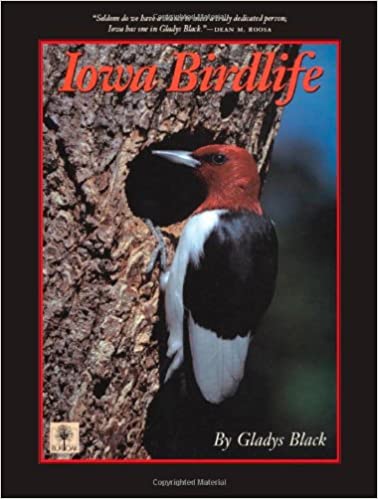Background
Gladys was born on January 4, 1909, in Pleasantville, Iowa, United States; the daughter of James M. Bowery and Jerusha (Ford) Bowery.



(From robins nesting on window ledges to short-eared owls ...)
From robins nesting on window ledges to short-eared owls sailing low over snowy fields, pied-billed grebes diving for fish to catbirds singing on moonlit nights, Black introduces us to the birds of field and forest, prairie and pond.
https://www.amazon.com/Iowa-Birdlife-Bur-Oak-Book/dp/0877453934
1992
conservationist ornithologist writer
Gladys was born on January 4, 1909, in Pleasantville, Iowa, United States; the daughter of James M. Bowery and Jerusha (Ford) Bowery.
Gladys attended Pleasantville High School and went on to obtain a nursing degree from Mercy Hospital in Des Moines, Iowa, United States, in 1930. She receibed a Bachelor of Science degree in public health nursing from the University of Minnesota in Minneapolis, Minnesota, United States.
In 1941 Gladys married Wayne Black, and moved with him to Robins Air Force Base in Warner Robins, Georgia, United States. While working for the U.S. Public Health Service, she became active in community affairs.
After the death of her husband in 1956, Black returned to Pleasantville. Fully occupied as a public health nurse and a caregiver for her mother, she nonetheless entered upon a new career, focusing her civic volunteerism on a different sort of community: birdlife. As an educator, wildlife rehabilitator, speaker, researcher, writer, and activist, Black used her considerable intelligence to inform the public about the singular beauty of birds and her considerable energy to ensure that their lifeways and habitats were defended and protected.
Immediately upon her return to Iowa, Black became actively involved in the Iowa Ornithologists’ Union. The Iowa skies were rich in avian life, both resident and migratory, and Black ultimately identified more than 300 species around Pleasantville. She organized bird-banding field trips and other nature projects for schoolchildren, systematically recorded data about the birdlife as well as the plants and animals around her, corresponded with other naturalists around the state and across the nation, opened her home to care for sick and wounded birds, and in many other ways endeavored to pass her knowledge and enthusiasm on to young and old alike.
In May 1970 Black became not just a strong environmentalist, but a radicalized one. Since the damming of the Des Moines River the previous year had created Lake Red Rock near her home, she hoped that great blue herons could nest successfully on the floodplain near Red Rock Bluff. In April it looked as if her hope would be realized: 12 pairs of the beautiful birds courted, built nests, and incubated eggs. By the end of May, however, their thin-shelled eggs had broken, and their nests were deserted. Black’s passionate demands for research into this crisis led to its cause: in her words, “a horrifying load of persistent pesticide residues in the embryos.” From then on, she was a relentless advocate for environmental health, and she had an enviable forum for her agenda: the renowned Des Moines Register.
In 1970 Black began writing a column for the newspaper, which at that time was widely read throughout the state. Black soon became a household name. Through her short, lively articles about Iowa birds, she reached thousands of readers, enlisting them in her campaign to protect their land and its avian inhabitants. She wrote for the Register until 1987, and after that she continued to write for weekly newspapers; her columns were collected in two well-received books, Birds of Iowa (1979) and Iowa Birdlife (1992).
Black’s relaxed and informal writing style was immediately accessible to laypeople yet authoritative enough for the professional. She created a world where birds were so undeniably significant that her readers accepted the necessity of protecting the habitat and safety of their avian neighbors. She provided engaging anecdotes and firsthand information to her readers, and in return they became her research partners by answering surveys, conducted through her columns, on evening grosbeaks and snowy owls.
In the summer of 1977 Black became even more of a household name when she took on the Iowa Conservation Commission, which had set a dove-hunting season for the forth-coming fall. According to her studies, a dove season went against the principles of good game management, and Black rallied support to take the commission to court. In the following session, the state legislature banned dove hunting in Iowa. Black called herself “strictly an amateur,” but her colleagues thought otherwise. The public voice of Iowa birdwatchers died on July 19, 1998.
In 1978 Simpson College gave to Gladys an honorary doctor of science degree.
The U.S. Army Corps of Engineers honored her for her conservation and education efforts around Lake Red Rock, and the Iowa Academy of Science presented her with an award of merit.
In 1985 Gladys was elected to the Iowa Women’s Hall of Fame. In 2004 the Iowa Natural Heritage Foundation established a bald eagle refuge at Lake Red Rock and a college scholarship in her honor.
(From robins nesting on window ledges to short-eared owls ...)
1992
Quotes from others about the person
Larry Stone said: “Black introduced thousands of Iowans to the joys of birds and birding. But her passion for protecting the environment and her scorn for despoilers of the earth remains an even more lasting legacy”.
In 1941 Gladys married Wayne Black.
